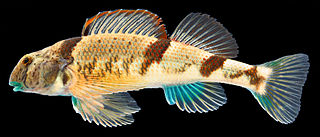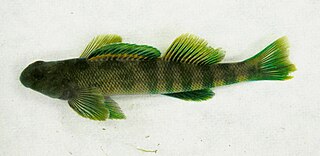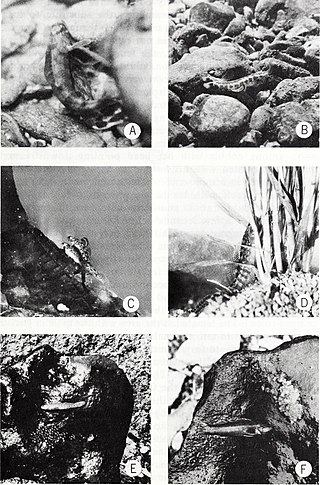The ashy darter is a species of freshwater ray-finned fish, a darter from the subfamily Etheostomatinae, part of the family Percidae, which also contains the perches, ruffes and pikeperches. It is endemic to the eastern United States.
The redband darter is a species of freshwater ray-finned fish, a darter from the subfamily Etheostomatinae, part of the family Percidae, which also contains the perches, ruffes and pikeperches. It is endemic to the state of Tennessee in the eastern United States.

The blenny darter is a species of freshwater ray-finned fish, a darter from the subfamily Etheostomatinae, part of the family Percidae, which also contains the perches, ruffes and pikeperches. It is a poorly known species which occurs in Alabama and Tennessee where it inhabits swift riffles.

The greenside darter is a species of freshwater ray-finned fish, a darter from the subfamily Etheostomatinae, part of the family Percidae, which also contains the perches, ruffes and pikeperches. It inhabits swift riffles in the eastern United States and southern Ontario.

The bluemask darter is a species of freshwater ray-finned fish, a darter from the subfamily Etheostomatinae, part of the family Percidae, which also contains the perches, ruffes and pikeperches. It is endemic to the eastern United States. It is a federally listed endangered species of the United States. This fish was not formally described until 2009, but it was added to the US Endangered Species List in 1993. During breeding, the male has bright blue patches on its head and other areas. This fish is found only in the Caney Fork River system, a tributary of the Cumberland River in Tennessee. The species name akatulo comes from the Cherokee for "mask", referring to the solid blue coloration on the lower face of the fish.
The Cumberland snubnose darter is a species of freshwater ray-finned fish, a darter from the subfamily Etheostomatinae, part of the family Percidae, which also contains the perches, ruffes and pikeperches. This species is found in the middle Cumberland River drainage in Tennessee, Kentucky, Virginia, North Carolina, Georgia, and Alabama. It is absent in reaches above the Big South Fork, rare in North Carolina, and absent in western tributaries of the Tennessee River. While research on the ecology of E. atripinne is not extensive, what is known is they are usually found in small to medium freshwater streams in gravel riffle areas where their eggs can attach to the substrate and be left unguarded. E. atripinne can be found within a wide range of depths in its environment, leading its being classified as benthopelagic. While its global status is secure, the American Fisheries Society labels it with a status of “Special Concern”.
The emerald darter, is a species of freshwater ray-finned fish, a darter from the subfamily Etheostomatinae, part of the family Percidae, which also contains the perches, ruffes and pikeperches. It is found only in northern and eastern Kentucky and northeastern Tennessee.

The teardrop darter is a species of freshwater ray-finned fish, a darter from the subfamily Etheostomatinae, part of the family Percidae, which also contains the perches, ruffes and pikeperches. It is endemic to the eastern United States. It is only found in Kentucky and Tennessee, where it occurs in the middle to upper reaches of the Green River drainage. It inhabits small rivers and creeks and rocky pools where it feeds on the larvae of blackflies and midges, immature stages of caddisflies and mayflies, and cladocerans and copepods. This species can reach a length of 6 cm (2.4 in), though most only reach about 4.2 cm (1.7 in). This species creates nests in which the females deposit their eggs and these are guarded by the male and have been found to contain between 40 and 80 eggs. The teardrop darter was first formally described by Robert A. Kuehne and James W. Small Jr. in 1971 with the type locality given as Brush Creek, a tributary of the Green River, 2.7 miles north of Liberty, Casey County, Kentucky. The specific name honours Professor Roger W. Barbour (1919-1993) in recognition of his contribution to the knowledge of Kentucky's vertebrate fauna.

The buffalo darter is a species of freshwater ray-finned fish, a darter from the subfamily Etheostomatinae, part of the family Percidae, which also contains the perches, ruffes and pikeperches. It is found in the tributaries of the lower Duck and lower Tennessee Rivers. It is distinguished from other darter species by the presence of eight anal rays, as well breeding males having a unique hump behind the head reminiscent of a buffalo.
The greenfin darter is a species of freshwater ray-finned fish, a darter from the subfamily Etheostomatinae, part of the family Percidae, which also contains the perches, ruffes and pikeperches. It is endemic to the eastern United States.
The golden darter is a species of freshwater ray-finned fish, a darter from the subfamily Etheostomatinae, part of the family Percidae, which also contains the perches, ruffes and pikeperches. It is found in the upper Tennessee River, one of the over 300 fish species found in Tennessee.
The saffron darter is a species of freshwater ray-finned fish, a darter from the subfamily Etheostomatinae, part of the family Percidae, which also contains the perches, ruffes and pikeperches. It is endemic to the eastern United States, where it is found in streams and creeks in Kentucky and Tennessee.
The stripetail darter is a species of freshwater ray-finned fish, a darter from the subfamily Etheostomatinae, part of the family Percidae, which also contains the perches, ruffes and pikeperches. It is endemic to the eastern United States. It is found in small rivers and streams in the states of Tennessee, Ohio, Kentucky, Illinois, Alabama, Georgia, and Mississippi. Males are a golden-orange color with black barring on the fins, and grow to a length of about 2.8 in (7 cm). This fish feeds on midge larvae and other small invertebrates. It breeds in the spring; eggs are attached to the substrate, often under slab rocks, where they are guarded by the male. The population trend of this fish seems to be stable and it is a common species with numerous sub-populations over a wide range, and the International Union for Conservation of Nature has assessed its conservation status as being of "least concern".

The snubnose darter is a species of freshwater ray-finned fish, a darter from the subfamily Etheostomatinae, part of the family Percidae, which also contains the perches, ruffes and pikeperches. It is endemic to the southeastern United States.

The orangethroat darter is a species of freshwater ray-finned fish, a darter from the subfamily Etheostomatinae, part of the family Percidae, which also contains the perches, ruffes and pikeperches. It is endemic to the central and eastern United States where it is native to parts of the Mississippi River Basin and Lake Erie Basin. Its typical habitat includes shallow gravel riffles in cooler streams and rocky runs and pools in headwaters, creeks, and small rivers, with sand, gravel, rubble, or rock substrates. It forages on the bottom for the aquatic larvae of midges, blackfly, mayfly and caddisfly, as well as isopods and amphipods. Spawning takes place in spring, the selected sites often being the upper stretches of riffles with sandy and gravelly bottoms interspersed with larger cobble. Reproductive success is high in this species. No particular threats have been identified, and the International Union for Conservation of Nature has assessed its conservation status as being of "least concern".
The spottail darter is a species of freshwater ray-finned fish, a darter from the subfamily Etheostomatinae, part of the family Percidae, which also contains the perches, ruffes and pikeperches. It is endemic to the eastern United States. It is found in the Ohio River basin and in the Red River system of the Cumberland River drainage. It inhabits rocky pools and nearby riffles of flowing waters up to the size of small rivers.

Nothonotus is a genus or subgenus of freshwater ray-finned fish, a darter from the subfamily Etheostomatinae, part of the family Percidae, which also contains the perches, ruffes and pikeperches. It is endemic to the southeastern United States. First proposed as a sub-genus of Etheostoma in 1988, there is still debate regarding the appropriate taxonomic rank of Nothonotus in the literature. Darter species comprise more than 180 of the Percidae taxa.
The Kentucky darter is a species of freshwater ray-finned fish, a darter from the subfamily Etheostomatinae, part of the family Percidae, which also contains the perches, ruffes and pikeperches. It is endemic to the eastern United States, where it occurs in the upper Green and Gasper River systems in Kentucky. It inhabits rocky pools and adjacent riffles of creeks and small rivers. It has a diet that mainly consists of mayflies, larval blackflies, midges and occasionally various insect larvae. This species can reach a length of 6.5 cm (2.6 in).
The Tennessee darter is a species of freshwater ray-finned fish, a darter from the subfamily Etheostomatinae, part of the family Percidae, which also contains the perches, ruffes and pikeperches. It is endemic to the eastern United States, where it occurs in the Tennessee River drainage from western Virginia to western Tennessee. It also occurs in the upper Bluestone River drainage in western Virginia. It inhabits current-swept rocky pools and adjacent riffles of creeks and small to medium rivers. This species can reach a length of 6 cm (2.4 in).
The East Rim darter is a species of freshwater ray-finned fish, a darter from the subfamily Etheostomatinae, part of the family Percidae, which also contains the perches, ruffes and pikeperches. It is endemic to the eastern United States. The species has a range of 400-2000 sq. miles across tributaries of the Cumberland River from Fishing Creek in Kentucky to just below the Obey River in Tennessee. It inhabits current-swept rocky pools and adjacent riffles of creeks and small to medium rivers.








